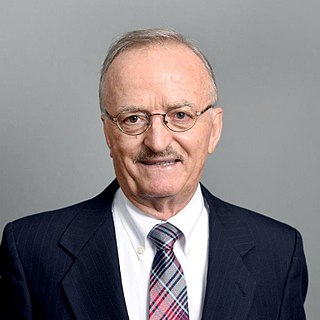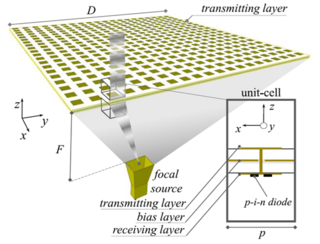Related Research Articles

The NASA Deep Space Network (DSN) is a worldwide network of spacecraft communication ground segment facilities, located in the United States (California), Spain (Madrid), and Australia (Canberra), that supports NASA's interplanetary spacecraft missions. It also performs radio and radar astronomy observations for the exploration of the Solar System and the universe, and supports selected Earth-orbiting missions. DSN is part of the NASA Jet Propulsion Laboratory (JPL).

A CubeSat is a class of small satellite with a form factor of 10 cm (3.9 in) cubes. CubeSats have a mass of no more than 2 kg (4.4 lb) per unit, and often use commercial off-the-shelf (COTS) components for their electronics and structure. CubeSats are deployed into orbit from the International Space Station, or launched as secondary payloads on a launch vehicle. As of December 2023, more than 2,300 CubeSats have been launched.
Extremely high frequency is the International Telecommunication Union designation for the band of radio frequencies in the electromagnetic spectrum from 30 to 300 gigahertz (GHz). It lies between the super high frequency band and the far infrared band, the lower part of which is the terahertz band. Radio waves in this band have wavelengths from ten to one millimeter, so it is also called the millimeter band and radiation in this band is called millimeter waves, sometimes abbreviated MMW or mmWave. Millimeter-length electromagnetic waves were first investigated by Jagadish Chandra Bose, who generated waves of frequency up to 60 GHz during experiments in 1894–1896.
IEEE 802.11n-2009, or 802.11n, is a wireless-networking standard that uses multiple antennas to increase data rates. The Wi-Fi Alliance has also retroactively labelled the technology for the standard as Wi-Fi 4. It standardized support for multiple-input multiple-output, frame aggregation, and security improvements, among other features, and can be used in the 2.4 GHz or 5 GHz frequency bands.

Constantine A. Balanis is a Greek-born American scientist, educator, author, and Regents Professor at Arizona State University. Born in Trikala, Greece on October 29, 1938. He is best known for his books in the fields of engineering electromagnetics and antenna theory. He emigrated to the United States in 1955, where he studied electrical engineering. He received United States citizenship in 1960.

Ian F. Akyildiz is a Turkish-American electrical engineer. He received his BS, MS, and PhD degrees in Electrical and Computer Engineering from the University of Erlangen-Nürnberg, Germany, in 1978, 1981 and 1984, respectively. Currently, he is the President and CTO of the Truva Inc. since March 1989. He retired from the School of Electrical and Computer Engineering (ECE) at Georgia Tech in 2021 after almost 35 years service as Ken Byers Chair Professor in Telecommunications and Chair of the Telecom group.
IEEE 802.11b-1999 or 802.11b is an amendment to the IEEE 802.11 wireless networking specification that extends throughout up to 11 Mbit/s using the same 2.4 GHz band. A related amendment was incorporated into the IEEE 802.11-2007 standard.

In radio, multiple-input and multiple-output (MIMO) is a method for multiplying the capacity of a radio link using multiple transmission and receiving antennas to exploit multipath propagation. MIMO has become an essential element of wireless communication standards including IEEE 802.11n, IEEE 802.11ac, HSPA+ (3G), WiMAX, and Long Term Evolution (LTE). More recently, MIMO has been applied to power-line communication for three-wire installations as part of the ITU G.hn standard and of the HomePlug AV2 specification.
WiGig, alternatively known as 60 GHz Wi-Fi, refers to a set of 60 GHz wireless network protocols. It includes the current IEEE 802.11ad standard and also the IEEE 802.11ay standard.
Theodore (Ted) Scott Rappaport is an American electrical engineer and the David Lee/Ernst Weber Professor of Electrical and Computer Engineering at New York University Tandon School of Engineering and founding director of NYU WIRELESS.

Robert W. Heath Jr. is an American electrical engineer, researcher, educator, wireless technology expert, and a Professor in the Department of Electrical and Computer Engineering at the University of California, San Diego. He is also the president and CEO of MIMO Wireless Inc. He was the founding director of the Situation Aware Vehicular Engineering Systems initiative.

Mars Cube One was a Mars flyby mission launched on 5 May 2018 alongside NASA's InSight Mars lander. It consisted of two nanospacecraft, MarCO-A and MarCO-B, that provided real-time communications to Earth for InSight during its entry, descent, and landing (EDL) on 26 November 2018 - when InSight was out of line of sight from the Earth. Both spacecraft were 6U CubeSats designed to test miniaturized communications and navigation technologies. These were the first CubeSats to operate beyond Earth orbit, and aside from telecommunications they also tested CubeSats' endurance in deep space. On 5 February 2019, NASA reported that both the CubeSats had gone silent by 5 January 2019, and are unlikely to be heard from again. In August 2019, the CubeSats were honored for their role in the successful landing of the InSight lander on Mars.

Kamal Sarabandi is an Iranian-American scientist and the Fawwaz T. Ulaby Distinguished University Professor of EECS and the Rufus S. Teesdale endowed Professor of Engineering at the University of Michigan, where he teaches and conducts research on the science and technology of microwave and millimeter wave radar remote sensing, wireless technology, electromagnetic wave propagation and scattering, metamaterials, antenna miniaturization, and nano antennas.
Debatosh Guha is an Indian researcher and educator. He is a Professor at the Institute of Radio Physics and Electronics at the Rajabazar Science College, University of Calcutta. He is an Adjunct faculty at the National Institute of Technology Jaipur and had also served Indian Institute of Technology Kharagpur as HAL Chair Professor for a period during 2015-2016.

Ingenuity, nicknamed Ginny, is an autonomous NASA helicopter that operated on Mars from 2021 to 2024 as part of the Mars 2020 mission. Ingenuity made its first flight on April 19, 2021, demonstrating that flight is possible in the extremely thin atmosphere of Mars, and becoming the first aircraft to conduct a powered and controlled extra-terrestrial flight. It was designed by NASA's Jet Propulsion Laboratory (JPL) in collaboration with AeroVironment, NASA's Ames Research Center and Langley Research Center with some components supplied by Lockheed Martin Space, Qualcomm, and SolAero.

A transmitarray antenna is a phase-shifting surface (PSS), a structure capable of focusing electromagnetic radiation from a source antenna to produce a high-gain beam. Transmitarrays consist of an array of unit cells placed above a source (feeding) antenna. Phase shifts are applied to the unit cells, between elements on the receive and transmit surfaces, to focus the incident wavefronts from the feeding antenna. These thin surfaces can be used instead of a dielectric lens. Unlike phased arrays, transmitarrays do not require a feed network, so losses can be greatly reduced. Similarly, they have an advantage over reflectarrays in that feed blockage is avoided.
Mahta Moghaddam is an Iranian-American electrical and computer engineer and William M. Hogue Professor of Electrical Engineering in the Ming Hsieh Department of Electrical and Computer Engineering at the University of Southern California Viterbi School of Engineering. Moghaddam is also the president of the IEEE Antennas and Propagation Society and is known for developing sensor systems and algorithms for high-resolution characterization of the environment to quantify the effects of climate change. She also has developed innovative tools using microwave technology to visualize biological structures and target them in real-time with high-power focused microwave ablation.

The Lunar Crater Radio Telescope (LCRT) is a proposal by the NASA Institute for Advanced Concepts (NIAC) to create an ultra-long-wavelength radio telescope inside a lunar crater on the far side of the Moon.

Douglas Henry Werner is an American scientist and engineer. He holds the John L. and Genevieve H. McCain Chair Professorship in the Penn State Department of Electrical Engineering and is the director of the Penn State University Computational Electromagnetics and Antennas Research Laboratory. Werner holds 20 patents and has over 1090 publications. He is the author/co-author of 8 books. According to Google Scholar, his h-index is 79 with more than 26,600 citations. He is internationally recognized for his expertise in electromagnetics, antenna design, optical metamaterials and metamaterial-enabled devices as well as for the development/application of inverse-design techniques.

Yang Hao is a British electrical engineer, academic, and author most known for his research in wireless connectivity and metamaterials. He is the holder of the QinetiQ/Royal Academy of Engineering (RAE) Research Chair, and serves as the Director of both the EPSRC Research Centre on Future Wireless Connectivity and the EPSRC Centre for Transformation Optics and Metamaterials. He is also a Professor of Antennas and Electromagnetics, and Deputy Vice Principal for Strategic Research at Queen Mary University of London (QMUL). He is a Co-Founder and Director of AOTOMAT, and co-founded a satellite communication company called Isotropic Systems.
References
- 1 2 VENTOUILLAC, Jean (2022-12-12). "PORTRAIT. Nacer Chahat, ce Rennais qui repousse les frontières de l'humanité avec la Nasa". Ouest-France (in French). Retrieved 2023-12-07.
- 1 2 "PORTRAIT. Nacer Chahat, un Agenais à la NASA". La Dépêche du Midi (in French). Retrieved 2023-12-07.
- 1 2 3 4 "Nacer Chahat". IEEE. Retrieved 2023-12-07.
- ↑ "EN IMAGES – Un ancien élève de l'Université de Rennes 1 dans l'équipe de l'hélicoptère Ingenuity de la Nasa – France Bleu". ici, par France Bleu et France 3 (in French). 2021-04-19. Retrieved 2023-12-07.
- ↑ https://ieeexplore.ieee.org/author/37594625700
- 1 2 3 4 5 6 7 "Nacer Chahat | Science and Technology". scienceandtechnology.jpl.nasa.gov. Retrieved 2023-12-07.
- ↑ "Season 5, Episode 2: Talking to Ingenuity and Other Space Robots – NASA" . Retrieved 2023-12-07.
- 1 2 3 "Nacer Chahat | Science and Technology". scienceandtechnology.jpl.nasa.gov.
- ↑ "Interview: Nacer Chahat Designs Antennas For Mars CubeSats". February 22, 2017.
- ↑ "Des antennes à fleur de peau | Espace des sciences". www.espace-sciences.org. Retrieved 2023-12-07.
- ↑ "Sergei A. Schelkunoff Transactions Prize Paper Award". IEEE Transactions on Antennas and Propagation. 65 (12): 6810–6812. December 2017. Bibcode:2017ITAP...65.6810.. doi:10.1109/TAP.2017.2770241.
- ↑ "The Lew Allen Award for Excellence Recipients | Science and Technology". scienceandtechnology.jpl.nasa.gov. Retrieved 2023-12-07.
- 1 2 "Areas of Achievement | Science and Technology". scienceandtechnology.jpl.nasa.gov. Retrieved 2023-12-07.
- ↑ "SPIE Journal of Applied Remote Sensing Honors Best Papers". spie.org. Retrieved 2023-12-07.
- ↑ https://www.ieee.org/content/dam/ieee-org/ieee/web/org/about/fellows/2022-ieee-fellows-class.pdf
- ↑ HUAUMÉ, Jean VENTOUILLAC et Hugo (2022-12-30). "L'ingénieur de la Nasa Nacer Chahat, élu Rennais de l'année par les internautes". Ouest-France.fr (in French). Retrieved 2023-12-07.
- ↑ "AIAA Announces its Class of 2024 Associate Fellows". www. Retrieved 2023-12-07.